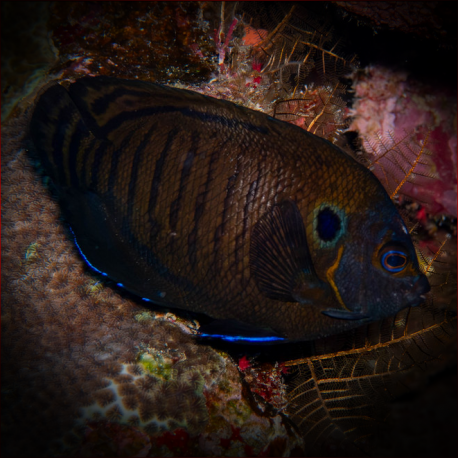More info
Datasheet
| Minimum Tank Size | 300 litres / 79.25 US gallons |
| Maximum Size | 14.0cm / 5.51inches |
| Reef Compatible | Not reef safe |
| Temperament | Mostly peaceful but might be aggressive towards similar species |
| Temperature | 22.2°C / 71.96°F - 25.6°C / 78.08°F |
| Specific Gravity | 1.020-1.025 |
| Carbonate Hardness | 8-12 |
| pH | 8.1-8.4 |
General Description
The Dusky Angelfish, scientifically known as Centropyge multispinis, belongs to the Pomacanthidae family and is a member of the Centropyge genus. These Dwarf Angelfish are characterized by their vibrant colors, making them a popular choice for aquarium enthusiasts. They typically grow to about 10 cm, with some individuals reaching up to 18 cm.
Aquarium Suitability
Considered suitable with care, the Dusky Angelfish requires specific attention to thrive in an aquarium setting. They are known to nibble on large polyp stone coral (LPS), other invertebrates, small crustaceans like krill and mysis, and soft corals. Due to their potential to disturb LPS, Zoanthus, and clams by consuming coral-produced mucus, caution is advised when considering their compatibility in a reef tank.
Demands, Care, and Hardiness
The Dusky Angelfish is rated as having average hardiness levels. They mainly feed on microalgae and detritus, with some species like C. loriculus and C. flavissima also consuming microalgae and green hair algae. To ensure their well-being, a varied diet comprising Spirulina, nori, and fresh vegetables is recommended. Additionally, these angelfish may require hiding spots in the aquarium, especially when introduced into a new environment.
Reef Suitability
The Dusky Angelfish is generally not considered reef-safe due to their tendency to target soft corals and LPS. While some species have a reasonable chance of coexisting in a reef tank, there is always a risk associated with introducing Dwarf Angelfish to such environments. Careful selection of corals, such as Hammer corals, Bubble corals, and Disc anemones, can help mitigate potential coral damage by these angelfish.
Aquarium Setup
When setting up an aquarium for the Dusky Angelfish, it is important to include sufficient hiding places to provide security, especially during the acclimatization phase. Maintaining a well-established tank with ample algae for grazing is beneficial for their nutrition. Ensuring a tank size of at least 300 liters, along with stable water conditions (pH 8.1-8.4, temperature 22.2-25.6°C, specific gravity 1.020-1.025, and alkalinity of 8-12 dKH), is recommended for their overall health.
Behaviour
Although mostly peaceful, the Dusky Angelfish can display aggression towards similar species, necessitating cautious selection and monitoring when housing multiple angelfish together. Their ability to change gender from female to male adds an interesting dynamic to their behavior in aquarium settings.
Feeding and Diet
Offering a diet rich in microalgae, such as Spirulina, is crucial for the nutritional requirements of the Dusky Angelfish. Providing varied food options, including fresh vegetables and algae-based supplements, helps maintain their health and helps them adapt to different stressors that may arise in the tank environment.
Dimorphism and Captive Reproduction
The Dusky Angelfish can change gender from female to male as needed for reproduction. This unique trait adds to the intrigue of their captive behavior and breeding possibilities, enhancing their appeal to aquarists interested in observing natural behaviors within a controlled environment.
Habitat and Distribution
Native to the Indo-West Pacific region, the Dusky Angelfish can be found in waters stretching from East Africa to western Thailand. Their habitat encompasses a diverse range of reef environments, where they contribute to the ecosystem as colorful and vibrant members of the marine community.

